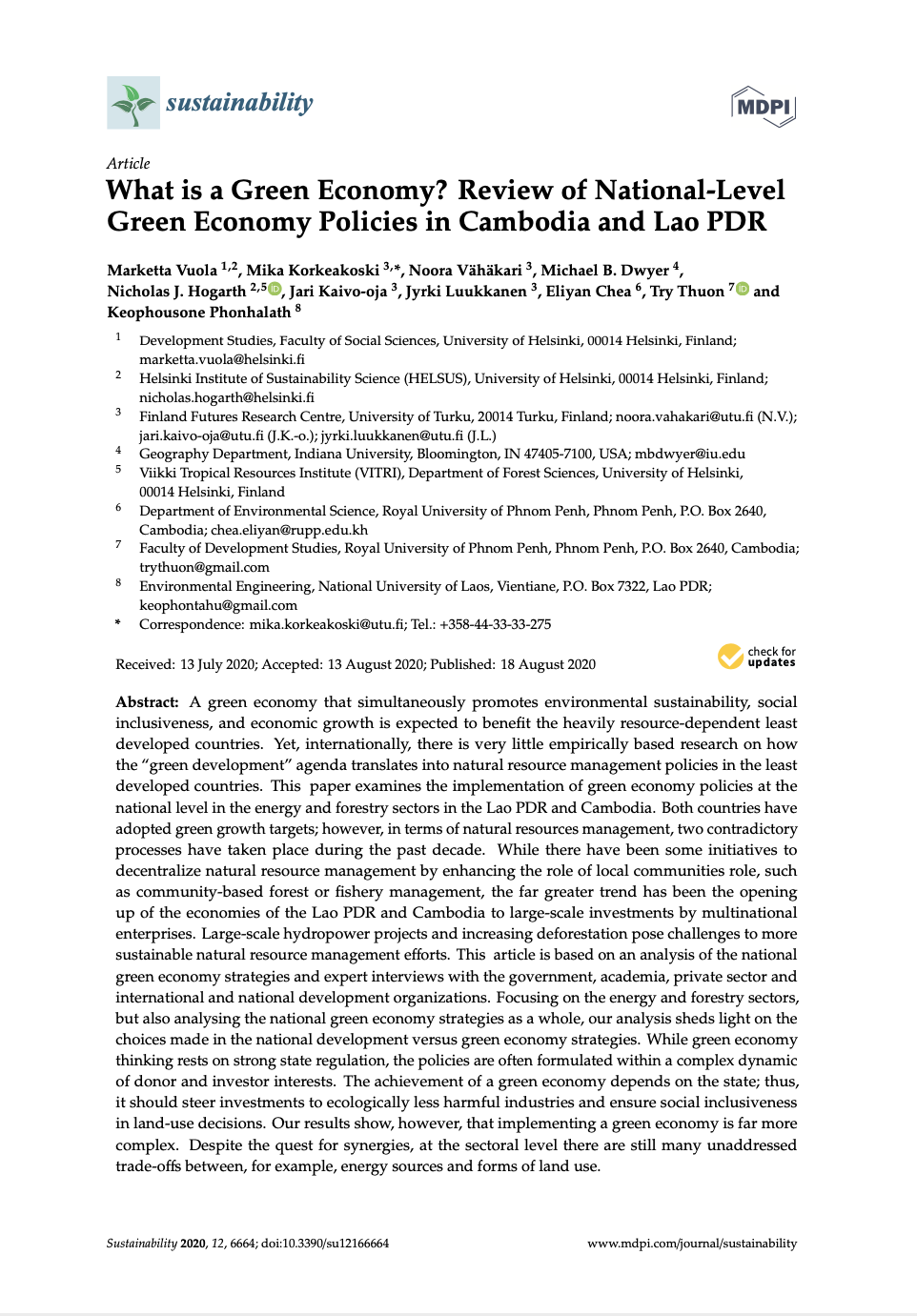
Keyword(s)
Author(s)
Marketta Vuola, Mika Korkeakoski, Noora Vähäkari, Michael B. Dwyer, Nicholas J. Hogarth, Jari Kaivo-oja, Jyrki Luukkanen, Eliyan Chea, Try Thuon, Keophousone Phonhalath
Publisher
Published Date
Access
DOI
1) Development Studies, Faculty of Social Sciences, University of Helsinki, 00014 Helsinki, Finland
2) Helsinki Institute of Sustainability Science (HELSUS), University of Helsinki, 00014 Helsinki, Finland
3) Finland Futures Research Centre, University of Turku, 20014 Turku, Finland
4) Geography Department, Indiana University, Bloomington, IN 47405-7100, USA
5) Viikki Tropical Resources Institute (VITRI), Department of Forest Sciences, University of Helsinki, 00014 Helsinki, Finland
6) Department of Environmental Science, Royal University of Phnom Penh, Phnom Penh, P.O. Box 2640, Cambodia
7) Faculty of Development Studies, Royal University of Phnom Penh, Phnom Penh, P.O. Box 2640, Cambodia
8) Environmental Engineering, National University of Laos, Vientiane, P.O. Box 7322, Lao PDR
A green economy that simultaneously promotes environmental sustainability, social inclusiveness, and economic growth is expected to benefit the heavily resource-dependent least developed countries. Yet, internationally, there is very little empirically based research on how the “green development” agenda translates into natural resource management policies in the least developed countries. This paper examines the implementation of green economy policies at the national level in the energy and forestry sectors in the Lao PDR and Cambodia. Both countries have adopted green growth targets; however, in terms of natural resources management, two contradictory processes have taken place during the past decade. While there have been some initiatives to decentralize natural resource management by enhancing the role of local communities role, such as community-based forest or fishery management, the far greater trend has been the opening up of the economies of the Lao PDR and Cambodia to large-scale investments by multinational enterprises. Large-scale hydropower projects and increasing deforestation pose challenges to more sustainable natural resource management efforts. This article is based on an analysis of the national green economy strategies and expert interviews with the government, academia, private sector and international and national development organizations. Focusing on the energy and forestry sectors, but also analysing the national green economy strategies as a whole, our analysis sheds light on the choices made in the national development versus green economy strategies. While green economy thinking rests on strong state regulation, the policies are often formulated within a complex dynamic of donor and investor interests. The achievement of a green economy depends on the state; thus, it should steer investments to ecologically less harmful industries and ensure social inclusiveness in land-use decisions. Our results show, however, that implementing a green economy is far more complex. Despite the quest for synergies, at the sectoral level there are still many unaddressed trade-offs between, for example, energy sources and forms of land use.
Cite: Vuola, M., Korkeakoski, M., Vähäkari, N., Dwyer, M.B., Hogarth, N.J., Kaivo-oja, J., Luukkanen, J., Chea, E., Thuon, T., Phonhalath, K., 2020. What is a Green Economy? Review of National-Level Green Economy Policies in Cambodia and Lao PDR. Sustainability 12.